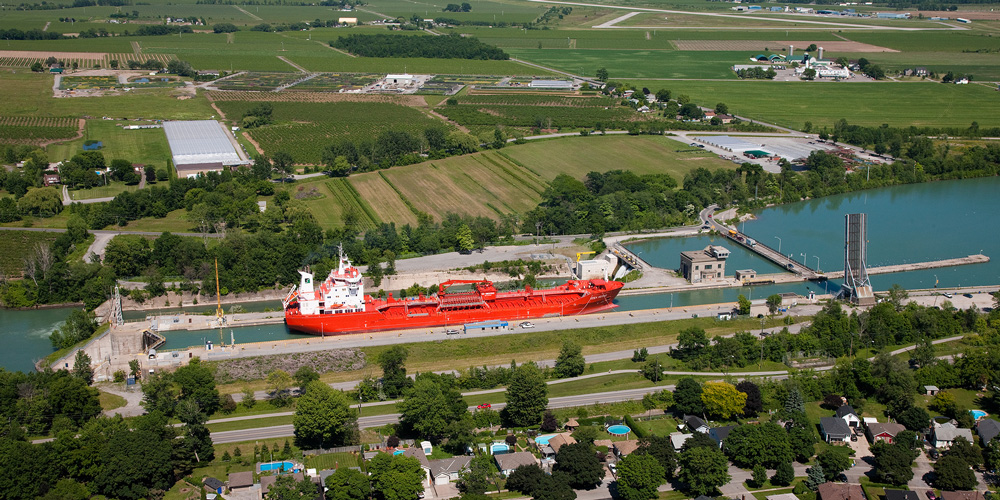St. Lawrence Seaway Fields First AIS Technology on Inland Waterway in the World
September 5, 2002
Montreal, September 5, 2002 – The Saint Lawrence Seaway Development Corporation and its Canadian partner, The St. Lawrence Seaway Management Corporation, unveiled their new automatic vessel identification system (AIS) in Montreal today, following a ceremony at St. Lambert Lock. The system is undergoing final tests this year, and will become mandatory for all Seaway commercial vessels at the start of the 2003 navigation season.
“This ceremony marks an important day for every mariner plying the St. Lawrence River and Great Lakes: AIS means a safer, more secure and efficient Seaway and that can only spell long-term benefits for our future,” said SLSDC Administrator Albert S. Jacquez.
SLSMC President Guy Véronneau agreed. “The deployment of AIS has been long in the making, but it is a great stride forward in navigation safety and efficiency. The two Seaway Corporations on both sides of the border adopted the strategy some time ago of leveraging technology to modernize the system and regain our competitive advantage. These cooperative efforts are now beginning to pay off. We have AIS in place, and we are forging ahead with e-business through our joint Web site. The Seaway is a going concern, a leader in using marine technology for the benefit of our customers.”
The AIS uses global positioning technology and the latest communication via universal VHF radio frequency to share vital marine navigation data from ship-to-ship, shore-to ship, and ship-to-shore in real time. Using the AIS communications protocol, vessels equipped with a transponder can be tracked by the three Seaway Vessel Traffic Control Centres (TCCs), which in turn transmit information back to the ships. All System traffic is thus aware of the exact location of any vessels in their vicinity, in any kind of weather. In addition, the Seaway TCCs transmit data such as lock order turn, water levels, current and wind speed and direction, and Seaway alerts or advisories, which a laptop computer aboard ship can call up instantly. The information is displayed on a virtual map of the Seaway, which changes as the data change.
The AIS promises improved safety, security and efficiency throughout the Seaway. Instant information about other vessels, such as type, size, position, course and speed greatly increases the margin of safety for crews in inclement weather and enhances environmental safety. In a time of heightened security concerns, AIS offers law enforcement officials a much-needed tool for responding more quickly and effectively in any emergency. System administrators will be able to schedule inspections and pilotage services in a more timely manner, effect better speed control, and schedule lockages and vessel tie-ups more efficiently. Finally, industry will see improved traffic and fleet management as transit times are reduced and ships save on fuel. Aggregate potential savings for all transiting vessels are estimated at $300,000 US annually.
Binational cooperation has characterized the AIS project, which was set in motion by the Saint Lawrence Seaway Development Corporation (SLSDC) and The St. Lawrence Seaway Management Corporation (SLSMC), some 10 years ago. Through agreements with the Canadian Shipowners Association and The Shipping Federation of Canada, the cost of implementing AIS was shared equally by commercial carriers using the waterway and the two Seaway management corporations. Today, senior marine transportation officials lauded the vision, technical excellence and commitment of the dozens of marine transportation engineers, technicians and managers who helped deliver the new system.
Following the ceremony, Seaway engineers and personnel from the DOT Volpe National Transportation Systems Center demonstrated the AIS capabilities on the Seaway Traffic Management System and onboard ship. Afterwards, journalists were invited aboard the Seaway Tug, Robinson Bay, to test out the system, where they communicated with a similarly equipped vessel and traffic controllers at the lock’s Traffic Control Center.
The new AIS system on the Seaway is the first to be fielded on a North American waterway, but others are following suit. The U.S. and Canadian Coast Guards propose to extend AIS coverage throughout the entire St. Lawrence/Great Lakes basin within a few years, and the International Maritime Organization is studying phased AIS implementation on shipping routes around the world.






